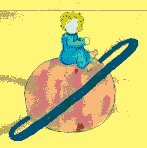

Ms. Grandin has an official website: Official Website of Temple Grandin
The information below is from Wikipedia.com (February 16, 2010):
Temple Grandin (born August 29, 1947) is a Doctor of Animal Science at Colorado State University, a bestselling author, and consultant to the livestock industry in animal behavior. As a person with high-functioning autism, Grandin is also widely noted for her work in autism advocacy and is the inventor of the hug machine designed to calm hypersensitive persons.
Grandin was born in Boston, Massachusetts, to Richard Grandin and Eustacia Cutler. She was diagnosed as autistic in 1950 [around age 3--author]. Having been labeled and diagnosed with brain damage at age two, she was placed in a structured nursery school with what she considers to have been good teachers. Grandin's mother spoke to a doctor who suggested speech therapy, and she hired a nanny who spent hours playing turn-based games with Grandin and her sister.
At age four, Grandin began talking, and she began making progress. She considers herself lucky to have had supportive mentors from primary school onwards. However, Grandin has said that middle school and were the worst parts of her life. She was the "nerdy kid", the one whom everyone teased and picked on. She would be walking down the street and people would say "tape recorder", because she would repeat things over and over again. Grandin states that "I could laugh about it now, but back then it really hurt".
After graduating from Hampshire Country School, a boarding school for gifted children in Rindge, New Hampshire in the 1960s, Grandin went on to college. She received her bachelor's degree in psychology from Franklin Pierce College (also located in Rindge) in 1970, her master's degree in animal science from Arizona State University in 1975, and her Ph.D. in animal science from the University of Illinois at Urbana-Champaign in 1989.
Grandin became well known after being described by Oliver Sacks in the title narrative of his book “An Anthropologist on Mars” (1995); the title is derived from Grandin's description of how she feels around neuroptypical people.
...Grandin has also been featured on major television programs, such as ABC's Primetime Live, the Today Show, and Larry King Live, and written up in Time magazine, People magazine, Forbes, and The New York Times. She was the subject of the Horizon documentary "The Woman Who Thinks Like A Cow," first broadcast by the BBC on June 8, 2006 and Nick News in the spring of 2006. She has also been a subject in the series First Person by Errol Morris. She is the focus of a semi-biographical HBO film, titled “Temple Grandin,” starring Claire Danes as Grandin. The film was released in 2010.
On November 1, 2009 Grandin was featured on a 3-hour interview on C-SPAN called "In Depth". This interview is available for view on the C-SPAN website.
...She has noted in her autobiographical works that autism affects every aspect of her life. She has to wear comfortable clothes to counteract her sensory integration dysfunction and has structured her lifestyle to avoid sensory overload. She regularly takes anti-depressants and uses a squeeze-box (hug machine) that she invented at the age of 18 as a form of stress relief therapy.
Before we can go any further, I should explain some things about this astrology.
Method
This astrological method is not the traditional Western one. It is not traditional, period. True, it uses sidereal astrology, the predominant (traditional) astrology of the East. It also uses the Egyptian harmonic. Both are quite old. This method started with me in 1983. Its working rules were not inherited. They were uncovered gradually through years of research. As they were uncovered, a system which at first seemed too complex became almost too simple. Here are those rules:
Chart Rules
Those interested in reading something about the difference between sidereal (“Eastern”) and tropical (“Western”) astrology can get some understanding from my paper on that subject:
The Sidereal and Tropical Zodiacs: A Discussion
The Home Page also contains information about this particular astrological approach. The background for its discovery, as well as an explanation of the Egyptian harmonic, are found in the paper on method:
About This Method
It is possible to read this paper without consulting any of those papers. The general understanding necessary to facilitate same are:
This approach uses both a birth and conception chart and they share the same axis. That means birth houses will overlap different houses of the conception chart. These are called house overlaps. Like paths, house overlaps play an important part in this astrology. Throughout this paper I use the convention when writing about house overlaps of putting the birth house first, then the conception house. So, for instance, a “5th/1st” overlap refers to an overlap of birth 5th house with conception 1st house in that order. A “9th/3rd” has birth 9th house overlapping conception 3rd house. Birth house/conception house in that order.
Birth planets (including their harmonics) rule only birth houses. Conception planets (including their harmonics) rule only conception houses.
Only conjunctions, applying and separating squares, and oppositions are recognized. Planets so related to each other are referred to as “in the same set.” A set, then, is two or more planets (or an Angle) connected to each other through conjunction, square, and opposition within the defined orbs (2nd paragraph below). The set is more active if it contains a light, and less active without one. Learning to look in terms of “crosses” can be helpful in rapidly finding planets that are in the same set.
”Lights” include suns, moons, and moons nodes. When mercury rules an Angle, especially if it rules two Angles (Gemini and Virgo), it functions both as a light and a planet. For instance, when mercury rules B MC and B Asc and is in the same set with mars and saturn, that constitutes a lighted (by mercury) mars/saturn set with forefront influence (the two Angles). MC and Asc act similar to lights in the sense they enliven and empower the expression of any planet they are touching, but they are not really lights, and their orb is smaller than regular lights.
All planets in a set are lighted, then, when the set includes an Angle, sun, moon, or nodes, and mercury when it rules at least one Angle.
Orbs for planets in sets with lights is 5°; without lights, about 2.5°. Orb for MC/planet or Asc/planet is 2°. Orb for progressed planet-to-Angle or vice versa is 1° and increases ½° - ¾° when a light is involved. If I could be certain each time of birth was absolutely correct, orbs could be established definitively.
In the paper on gurus I introduce the concept of path when speaking about an astrological set. Planets in a set, the houses they are in, and houses ruled by them describe an astrological path. If, for instance, planets in a set rule 4th, 5th and 9th houses, then the 4th, 5th, and 9th houses are inextricably connected to each other. Energy of learning as well as failure, determined by planets in the set, flows among those three houses. That connection between planets and houses is called their path. As can be seen, paths have profound implications.
Although the harmonic used for each chart is always 2 greater than the number of the chart, for ease in reading I have adopted the convention of writing the harmonic number the same as the chart number. For instance, “b12 mars” represents the harmonic of birth mars for the 12th chart (but the harmonic used to find b12 mars is the 14th).
In abbreviating, I use “b” for birth, “c” for conception, “p” for progressed, and “t” for transiting. A number following them, e.g., “3” or “7,” shows the harmonic chart we are examining. For instance, “b7 pluto” represents the harmonic of birth pluto for the 7th chart. “Pc3 mars” is the harmonic of progressed conception mars for the 3rd chart.
This method uses a solar return that occurs every 40 degrees (exactly) after birth up to death, with nine returns occurring annually.
The Main Significators for Autism
We want, first, to cite the results from the main and addendum papers on individuals diagnosed with autism. While there were some noted divergences in individual charts, they share a commonality described thus:
(1) Light/saturn/pluto (that is, a “set” containing light, saturn, and pluto conjunct, square, or opposition each other, see rules for reading this astrology, above) influencing an Angle and a 3rd house within the harmonic chart for the 1st house, also known as the 1st chart, of early childhood. Other planets may be in the set, but saturn and pluto must be and are defining.
The 1st chart is the chart that best (but not exclusively) describes our early childhood, its identity, and its somatic consequences. This set in this chart identifies that the “saturn/pluto” condition occurs during the early development (1st chart) of the individual.
(2) Light/saturn/pluto influencing an Angle and a 3rd house with the harmonic chart for the 3rd house, also known as the 3rd chart. Other planets may or may not be in the set, but saturn and pluto must be and are defining.
The 3rd chart, as a harmonic enlargement of the 3rd house, gives us critical information on the individual’s mental traits as well as some of the astrology of brain disorders.
Light/satun/pluto, in the conditions stated above, appear to define what is usually diagnosed as autism. Their influence results in early withdrawal, lack of identification with other humans and consequent failure to grow. I have papers on individuals who showed preponderant saturn/pluto in charts other than the 1st and 3rd. One is the paper on the disappearing priest (link on Home Page). My own experience of it around age 60 occurs in the main paper on autism. The paper on Asperger’s (link above) also shows saturn/pluto preponderance. All of these demonstrate excess of saturn/pluto in the 7th chart.
Admixtures of Other Disorders
Sets other than saturn/pluto were often, but not consistently, mixed in 1st and 3rd charts of autistic children. These other sets complicate a diagnosis of autistic. Their prevalence has resulted in the diagnostic labels Autistic Spectrum Disorder (ASD) and Pervasive Developmental Disorder (PDD), which cover wide ranges of “not-Bell-curve-normal” behavior shown by other childhood pathologies which can also occur with autism. (And that is the sense in which I use the term "pathological"--not fitting a behavioral Bell curve.) I discuss a number of examples of these below in the section labeled Discussion.
If not efficient, four types of circumstances can affect the signature. (1) It can be less than complete but not introducing other pathologies. (2) It can be “contaminated” by other pathologies, confusing the issue about which are the main significators. (3) It may contain the established significators, for instance, for the 1st chart, but not for the 3rd (another form of incomplete). (4) There may be some astrological condition(s) not yet identified which mitigates against autism, for instance, (a) for the autism involving mixed pathologies, or (2) possibly even when the early significators are pristine.
Most of us are mixtures of various talents, tendencies, and deficiencies. Smaller numbers of individuals are extreme in some way, for better or worse. I showed in the main paper that I considered the description of Elly Park to be an example of what I understand by the word “autism.” Her characteristics were extreme. She could be highly focused. She did not connect to others, even her mother. She had certain ongoing interests. She was rarely anxious or troubled. Her behavior had been patiently observed and catalogued by her loving mother. Her behavior could also be explained by forefront saturn and pluto in the 1st and 3rd charts, which I had found in other autistic charts.
If Grandin’s astrology for autism was pristine, I could, without further ado, simply show those sets below in the 1st and 3rd charts. If it were very efficient, I could do it with one set each in both charts.
Unfortunately, I only have the birth data for this one high-functioning individual. Some of her astrology, e.g., her very benefic 10th chart astrology--concerned with our social image, career, and >relationship to our mother is interesting. Grandin's !0th chart astrology is strongly positive, promoting her fame and high social esteem. Such highly benefic 10th charts do not occur that often even in charts of non-autistic people. (Think of what percentage of the human race is famous, or highly charismatic, or great leaders.) But it raises a question. Surely there are other autistic children who have superb relations to their mothers, and thus highly benefic 10th charts, who are not high functioning. So does Grandin's promote or create her higher capacity, or is it simply a reasonable outcome of something else--somewhere in her astrology--which does? Or is it in what is not in her astrology that creates "high functioning?" If so, what are the essential differences? Or is her higher functioning not in her astrology at all?
Her astrology does not conform to the "efficient pattern" for autism. Hers is mixed. That is, it shows parts (but not complete sets) of other pathologies. In order to show how it varies, we have to take an extensive look at sets influencing 3rd houses in the 1st and 3rd charts . Their examination takes patience, but it will show her variance from typical autistic.
Once her variances are established, in the Conclusion I speculate about their meaning. There, too, we examine her astrology relative to point (4) above. That is, she has some astrology the presence of which appears to mitigate against autism, helping her able to become high-functioning.
I am working on another chart of a woman definitely and only diagnosed with Asperger’s syndrome. With only one sample, I cannot know if her astrology was in any way typical of Asperger’s. Here I will state that her 1st and 3rd charts were not “autistic.” So, her identification with others and language skills were able to develop. Her strong saturn/pluto set showed up in her 7th chart. I have provided a link to her paper at the top of this one.
One more point seems desirable to mention. In the original paper on autism, I noted that all of the saturn/pluto sets included harmonics. None consisted entirely of non-harmonic planets. It is not that they cannot. It is just that the combination of non-harmonic planets with harmonic ones leads to changes in influence and path from chart to chart.
A word about the difference between a set containing a light and one containing an Angle:
Results from the two charts examined below are put in table form in the section labeled Conclusion. That makes them easier to see all at once.
Grandin, the 1st Chart of Childhood and Its Identity
We can now look at Grandin’s astrology, starting with her 1st chart.
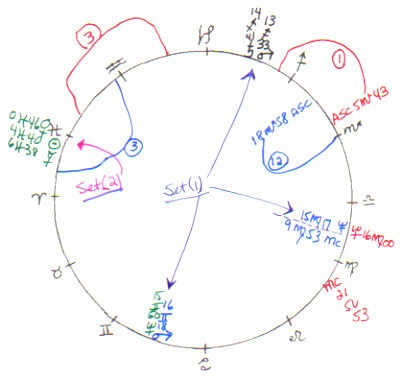
Set (2) is not an “autistic set” at all, but in the 1st chart it may represent some difficulty with language formation. It is in b 3rd house and c1 mercury rules B MC, so the set has forefront influence.
Examination of the 1st chart continues with Sets (3) and (4) below.
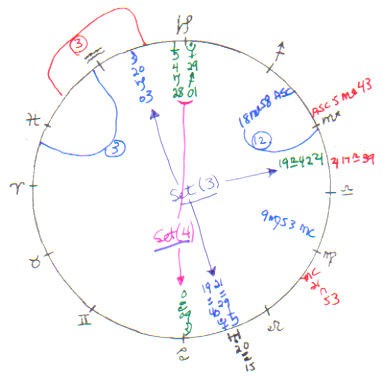
Set (3) has possible autistic significance because it contains light/saturn/pluto. It influences c 3rd house through c1 uranus, which co-rules (22 of 37°) it. But it is not on an Angle, and does not contain any planets which rule an Angle, so its manifestation is limited. It influences b 8th house through b moon, co-ruler (30 of 41°) b 8th.
There is a way both sets (3) would become more important. That would be if pluto ruled Scorpio. Then it would be ruling an Angle because the pluto in it rules B Asc. In all the time I have been doing this form of astrology (now almost 27 years), I have assigned rulership of Scorpio to mars. And I have never seen any need to change it. It goes with the double rulerships accorded to mercury and venus. Mercury rules Gemini and Virgo. Venus rules Taurus and Libra. And mars rules Aries and Scorpio. I see a lot of mars in the sign Scorpio. But, I have to admit, I see a lot of pluto. Then, possibly, both pluto and mars rule Scorpio. If that were the case. then Grandin would have a full "autistic set" (light/saturn/pluto/3rd/Angle) in this, her 1st chart, shown above as Set (3).
I cursorily examined charts used to write the main and addendum papers on autism to see what difference rulership by both mars and pltuo would make. Three individuals--Derek, 13740, and 14415 showed an increase in potency for the saturn/pluto significators for autism. But, of course that would be likely if both those planets ruled Scorpio.
Set (4) is the harmonic derivation of Set (3). It has lost its 3rd influence. It has kept its 8th influence. It is a lighted saturn/pluto which influences an 8th house.
I noted the two sets above also have 8th influence. It may be that that particular influence is sufficient to create the lack of connection to others. Combined with the other afflictions she has to 3rd houses: (1)(mars/saturn/neptune, (2) lighted mercury in Pisces, and (3) moon/saturn/pluto lacking Angle influence, an autistic diagnosis would have been reasonable, particularly if it included "high-functioning" as a possibility.
Summing, in her 1st chart we have seen sets which foster (1) anxiety and acute sensitivity (mars/saturn/neptune) and being mixed up about language (3rd influence), (2) slow development of language (mercury/Pisces/3rd), (3) and sets which could sponsor the emotional detachment that is part of autism (light/saturn/pluto/3rd/8th), but not create full-blown autism (no Angle influence), unless we allow pluto to co-rule Scorpio.
Grandin, Her 3rd Chart of Mind
Let's see what this chart shows us.

We have seen set (2) before in her 1st chart when it also contained harmonic uranus, co-ruler of c 3rd house. Here it has lost all harmonic planets. It lacks a 3rd influence, and it lacks an Angle ruler. It is not on an Angle. In this chart it has very little influence (unless we allow pluto to co-ruler Scorpio, then it influences B Asc). It does co-rule (30 of 41°) b 8th house through b moon, and, again, might sponsor some incapacity to connect emotionally with others (8th house). This set occurs in all twelve charts.
Examination of the 3rd chart continues with Sets (3) and (4) below.
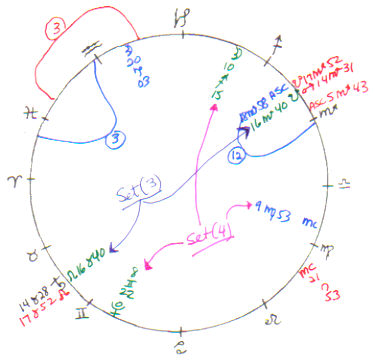
Set (3) above is a strong set. It contains Asc/node/node/mars/saturn. It contains an Angle (B Asc) and rules another through c mars, ruler of C Asc. It contains two lights (the nodes), and it contains a 3rd ruler through saturn, ruler of c 3rd house. It would be considered a set representing retardation except for retardation we need the same influence in the 1st chart, and her 1st chart does not have a lighted/mars/saturn influence. I know some one with this set in their 3rd chart (at least similar). He is quite intelligent, but when speaking often must “fish” for a moment for the words he wants. If he is around people who tend to “fill in the spaces,” he can get frustrated.
Set (4) is a straightforward Angle/moon/pluto (without saturn). It lacks 3rd influence, but does influence b 8th through b moon. I know some astrologers think pluto powerful. My own experience is that it puts a veil or membrane between the individual and others.
Examination of the 3rd chart continues with Sets (5) and (6) below.
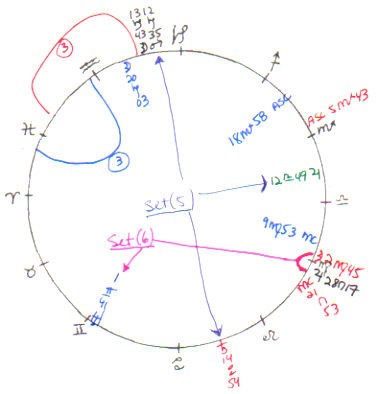
Set (5) is her second powerful 3rd chart set. It includes lighted mars/saturn. It influences C Asc through c3 mars. It influences c 3rd house through c3 saturn. It even influences c 8th house because c3 moon, co-ruler (15 of 37°) of c 8th house. This is her second lighted mars/saturn/3rd set in her 3rd chart. Once again, it needed a 1st chart similarity (and possibly other things) to manifest as retardation. It is not retardation. It is some kind of mental dissonance, and, with 8th chart influence, possibly a creating a mental desire to avoid the dissonance experienced through interactions with others (8th).
We have completed looking at Grandin’s difficult Angle/3rd sets for the 1st and 3rd charts. Now we want to look at two sets that, given that her “autistic sets” are not global in effect for those charts, leave room for other things, to happen.
Set (6) is the set that pertains to condition 4 in the section entitled Admixtures of Other Disorders. That is, my question was, are there some sets which seems to mitigate against autism. Here in the 3rd chart it is noteworthy because it contains the greater benefic, is lighted, and influences a 3rd house through b uranus, ruler of b 3rd. Here it is not real strong, but as it develops through later harmonics, in the 7th (significant others, and one-on-one interactions) and 10th (career and social image) charts its importance grows to describe the capacities of the Temple Grandin that is known to the public. She has an innovative and creative (uranus) mind (3rd house). Would it have developed had her autistic sets been stronger?
Grandin has another part to her astrology that shows strong mercuries which suggest a strong mind. That set, essentially an all-charts set, is shown below as Set (7).
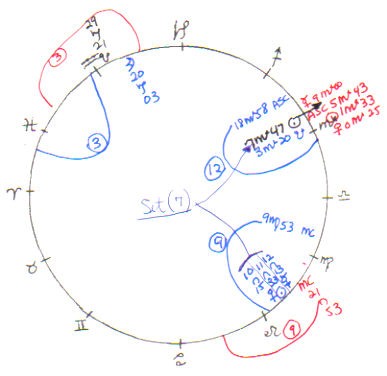
Set (7) contains two suns, two mercuries, and a venus. It conceivably even includes C Asc, but we don’t need it to get strong influence out of this set. C sun rules C MC. B mercury rules B MC (and therefore, also acts like a light in this set). So, the set contains three lights. It does not contain a 3rd ruler. However, mercury is natural ruler of the 3rd house, and this set contains two of them—birth and conception. The set is not affliction by mars, saturn, or neptune. The Leo planets are in both 9th houses. There are two “mind” houses. The 3rd house represents our “ordinary mind.” The 9th house represents our “higher mind.” People with 3rd/9th overlaps are functioning out of both at the same time, but in practice it has so far appeared that the 9th has usurped the 3rd, and the individual appears religious or philosophical to a high degree.
Set (7), then, appears a strong mercurial set which could sponsor the functions of mercury—communication, language, speaking, writing, and so on.
Since most of the set is non-harmonic, it occurs in all the charts. In the 1st chart it has lost the harmonic sun in Scorpio. It has acquired b1 SN at 10 Scorpio 00 and c1 moon at 8 Taurus 14—so, has one more light.
We have covered pertinent material in Grandin’s 1st and 3rd charts. Let’s move on to see what stands out in her 10th (career, social image) chart.
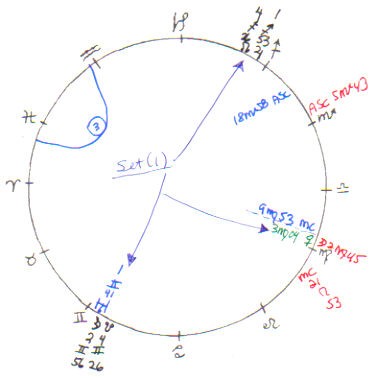
Set (1) above is the same as Set (6) (above) in her 3rd chart, but here it has “developed” nicely. It has acquired node/moon/venus/jupiter. That is, it has become a golden benefic with 3rd influence because b uranus rules b 3rd house. It does not influence an Angle, but it doesn’t have to in order to foster an excellent mind. Note that it contains SN/moon/uranus in Gemini, again stressing strong and innovative mentation.
C moon’s occurrence in the sign Virgo also helps. Virgo, as the sign of discriminating intelligence, works well with Gemini, the sign that stands for the capacity to work with words, ideas, and facts.
The occurrence of Set (1) in her 10th chart suggests she will have a reputation for very fine and innovative intelligence.
The same set in her 7th chart contains the non-harmonic moon/uranus and has acquired a NN at 0 Gemini 41, encouraging (NN) the development of iconoclastic and innovative (uranus) mentation (influences 3rd house as well as in Gemini/Virgo).
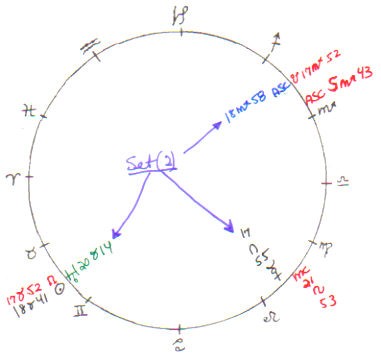
Set 2) above just shows another set that promises her intelligence will be socially recognized. Light/mercury/uranus shows superior intelligence. This set also is global in that it influences C MC through c10 sun and already includes a 2nd Angle, C Asc. It influences b3rd house through b10 uranus, ruler of b 3rd. And it contains two lights—the nodes and sun. This is a fitting 10th chart set for some one who has a PhD and who has successfully innovated more humane procedures for animals about to be slaughtered.
Also, b10 uranus, ruler of b 3rd, occurs at 15 Aquarius 10, lighted by c Nodes at 17° 52 Taurus/Scorpio, falling in both 3rd houses. This shows further development which promises her mind will be recognized socially as that of genius and innovation (uranus).
She has one more highly benefic set in her 10th chart:
| Set (3) | c venus | 0 Scorpio 25 | |
| c sun | 1 Scorpio 33 | ruler of C MC | |
| b SN | 3 Scorpio 20 | ||
| b10 neptune | 3 Scorpio 21 | ||
| C Asc | 5 Scorpio 43 | ||
| c10 venus | 4 Taurus 56 |
Set (3) shows sun/venus/node/neptune influencing two Angles. I am not sure how the neptune interprets. Her SN conjunct the Ascendant is part of her being seen as "different" because when our South Nodes are conjunct an Asc or MC we strike others as having something odd or less socially acceptable about ourselves. I covered this in the Eastern guru Osho's chart, in which he had a Scorpio SN conjunct his MC. Regardless of that, the set includes sun and two venuses--a benefic influence.
Conclusion With Regard to 1st and 3rd Charts
For my conclusion I have put results for difficult sets in the 1st and 3rd chart into tables. That will help make them more clear. But, first I want to present a few paragraphs which identify the implications of some of the sets found in the tables:
Lighted mars/saturn, indicative of breakdowns, difficult experiences, and exaggerated forms of lack or stress. Influencing an Angle and 3rd house in both the 1st and 3rd charts, they appear a significant part (if not the whole) of the significators for retardation.
Lights in Pisces (especially conjunct South Node or an Angle) or moon/neptune when forefront and influencing certain houses in either 1st or 3rd charts may result in various challenges. Corky, the autistic child institutionalized discussed in the main paper on autism, had Pisces moon conjunct Ascendant conjunct South Node in his 7th chart. His diagnosis, in addition to autism, was that of an “idiot.” That particular set occurring in any chart would pose a severe viability challenge to any individual who endured it. Moon/neptune influencing Angles and 3rd houses within the 3rd chart is part of the astrology of non-paranoid schizophrenia.
Lighted mars/neptune is indicative of toxic (mars) states of unreality (neptune) or distortions of reality. Influencing an Angle and 3rd house in the 3rd chart, they are part of the description of paranoid schizophrenia (mar/neptune). It was noteworthy they were not equally present in the 1st chart . Instead, to complete significators for schizophrenia, the 1st chart had a strong, lighted, and forefront saturn, apparently expressive of the lack of affect often seen in schizophrenia. But other astrological difficulties in the 1st chart which foster a weak identity also promote schizophrenia when the 3rd chart contain these significators. (See the paper on John Hinckley, Jr., link on Home Page).
Lighted mars/saturn/neptune, portray “siege conditions” in whichever chart they are forefront. They symbolize the breakdown (saturn) of toxic (mars) states of unreality (neptune) or distortions of reality (neptune). Forefront in the 1st chart of early childhood and the identity formed therein and influencing 3rd and 6th houses, they promote childhood asthma. Next chart up, in the 2nd chart, they promote “crazy” financial conditions (see paper on O.J. Simpson, link on Home Page). Forefront and influencing an Angle and 3rd house in the 3rd chart, they are part of the description of paranoid schizophrenia (mar/neptune) when the individual is hospitalized (see paper on John Forbes Nash, Jr.). Forefront in the 7th chart of our identity with others and influencing the end of life, depending on the path, they can sponsor anything from the siege conditions of dying of cancer to those of end-stage alcoholism to dying in (or on your way to) a concentration camp (latter example, astrologer Karl Ernst Krafft). Forefront in the 11th chart of group associations, they can stand for group suicide (see paper on Sects, link on Home Page).
Results for the 1st Chart Shown in Table Form
Here I will show only the defining planets for the set, dropping out, for instance, a planet like jupiter, which, as a planet, is not involved in defining autism. It may be involved in identifying house, but here we just want a tabulation of difficult influences. Influences to 3rd houses in the 1st chart are correlated with something about the mind. Influences to Angles identify its global nature. For the tables, I have used my original rulership scheme, that is, that mars alone rules Scorpio.
| Set No. | Planets Involved | Includes Light? | Includes Angle Ruler? | Includes 3rd House Ruler? |
| Set (1) | mars/saturn/neptune | No | Yes | Yes |
| Set (2) | sun/mercury/Pisces | Yes | Yes | Yes (In) |
| Set (3) | moon/saturn/pluto | Yes | No | Yes |
| Set (4) | moon/saturn/pluto | Yes | No | No |
Results for the 3rd Chart Shown in Table Form
Again, I show only the defining planets for the set, including whether or not the set contains a light, influences an Angle, and influences a 3rd house within the chart:
| Set No. | Planets Involved | Includes Light? | Includes Angle Ruler? | Includes 3rd House Ruler? |
| Set (1) | mars/saturn/neptune | No | Yes | No |
| Set (2) | moon/saturn/pluto | Yes | No | No |
| Set (3) | node/mars/saturn | Yes | Yes | Yes |
| Set (4) | moon/pluto | Yes | Yes | No |
| Set (5) | moon/mars/saturn | Yes | Yes | Yes |
I did not include sets (6) and (7) in the table because they are benefic sets having nothing to do with the development of autism. Here they are, though:
| Set No. | Planets Involved | Includes Light? | Includes Angle Ruler? | Includes 3rd House Ruler? |
| Set (6) | moon/jupiter/uranus | Yes | No | Yes |
| Set (7) | sun/mercury/venus | Yes | Yes | No, but includes 2 un-afflicted mercury |
In Set (7), we count it as influencing a 3rd house because it contains mercury, natural ruler of the 3rd house. It also influences two, maybe three, Angles (c sun rules C MC, b mercury rules B MC, and maybe we should include C Asc as part of the set.) This is a strong set that could develop a strong mind.
In the 1st chart Set (7), loses one of its Angle rulers, harmonic c sun, so it influences only two Angles (through b mercury, and this time, C Asc is definitely part of the set). It adds 1st harmonic planets in the form of c1 moon at 8 Taurus 14, and b1 South Node at 10 Scorpio. This is also a strong set that could develop a strong mind.
I am not going to recapitulate the strong positive sets in her 10th chart. They speak for themselves in the material above.
Discussion
If we do not allow pluto to co-rule Scorpio with mars, Grandin’s 1st and 3rd charts do not preclude the possibility of the mental development that is part our maturation. That is, her 3rd houses in each chart are sufficiently afflicted to cause lots of verbal/mental difficulties. Added to the lighted/saturn/pluto affliction to her 8th houses in both charts, we would have an individual (to use her words) who experiences considerable trouble in learning to communicate and also feels emotionally detached, but is still capable of connecting enough to establish some sort of foundation on which to build later development.
In that case, her capacity to be high-functioning results from the fact that her 3rd houses within each chart are not fully afflicted by the autistic planets, saturn and pluto. Plus the fact that her b 3rd house develops very positively in her 7th and 10th charts.
If it was the case that pluto shares rulership of Scorpio with mars, then Grandin's 1st is completely autistic (light/saturn/pluto/Angle/3rd path) and her 3rd chart somewhat autistic(lacks the 3rd influence). And 3rd houses in both charts are rather afflicted through the other afflictors, mars, saturn, and neptune. In that case, it would seem unlikely, but cannot be ruled out, that she could become high-functioning.
But if she did, then in that case, her high-functioning comes more starkly out of the favorable development in later charts of her ruler to b 3rd house.
I have just added the 8th house to the path for autism, which would then make the path: light/saturn/pluto/Angle/3rd/8th in the 1st and 3rd charts. This is just a first step to try to identify whether or not it belongs in the set. It would make sense from the point of view that the 8th house is fundamental in describing “fruits of relationship,” including emotional sharing. So, an affliction of lighted saturn/pluto to that house which started in 1st and/or 3rd charts could go a long way in accounting for the emotional detachment that can be part of autism. Influencing the 3rd house, it accounts for the withdrawal which occurs with autism.
Noteworthy, perhaps, is the fact that neither of Grandin’s 3rd houses within her 1st and 3rd charts contains the malefics, mars or saturn. They also lack the questionable neptune (at least at 1st and 3rd chart level). Instead, c 3rd house (in all charts) contains a "strong" moon, birth moon in Capricorn. It is correlated with an automatic (moon) interest in function and control (Capricorn), a good placement, it would seem, for struggling with various personal adversities. It is also good for the work she does in analyzing the structure and function of various situation for animals.
Neither 3rd house contains pluto, either. Since pluto is one of the planets involved in autism, it seems a good thing it is not in either of her 3rd houses. Three of the seven autistic individuals in the Addendum paper had non-harmonic pluto in a 3rd house (and possibly a fourth, if birth were a little earlier.), but not any in the original study of six. Of course, any of these planets--mars, saturn, pluto--can be in a 3rd house and not have anything to do with autism. They would simply add a little more pluto affliction in charts which already showed autistic or mental/verbal challenges.
Further Work
As stated above, I am working on a paper on an individual diagnosed with Asperger’s. Her astrology is very intriguing in the way it differs from "typical autistic."
I will present more charts of autistic individuals when and if I get their data.
I have not included control groups. To some extent, it is a question of who do I use as the control group? Otherwise, I have first been working in the area to see if autistic children shared anything in common astrologically. And, of course, having seen thousands of charts by now, I have a general idea what is "normal" in a chart and what is excessive. Lighted saturn/pluto in the 1st and 3rd charts of autistic individuals is excessive. Still, control groups are needed.

Contact the author at sleeweidner@yahoo.com